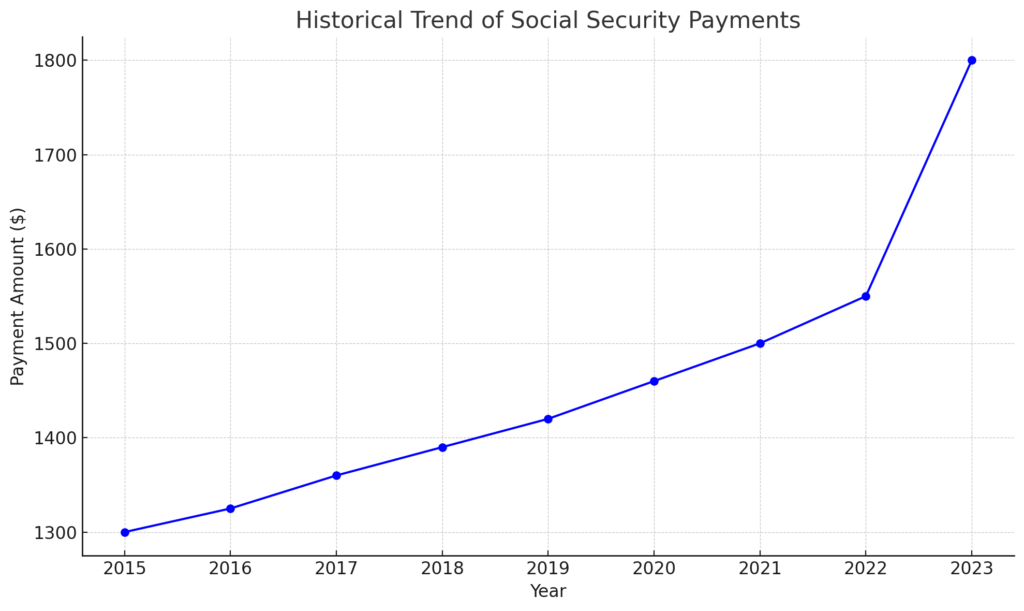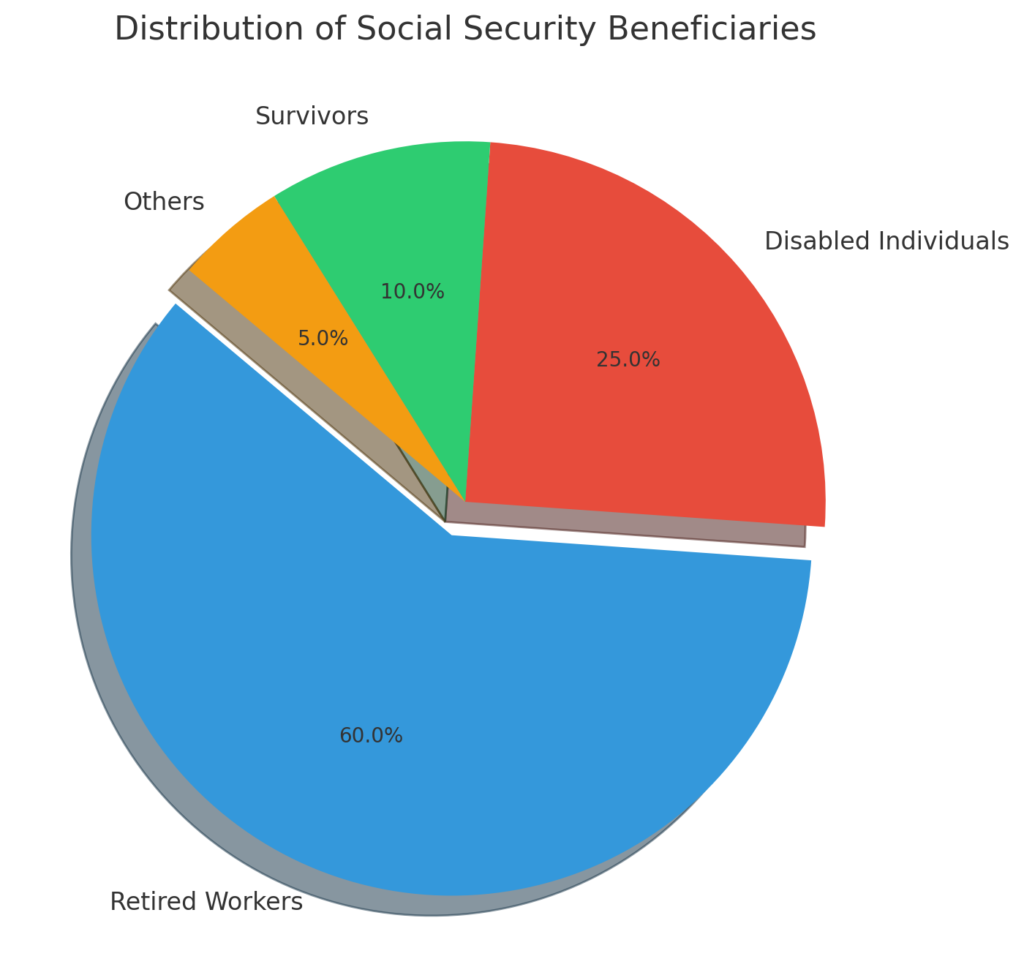Social Security, established in 1935, provides financial support to eligible individuals in the U.S. In 2023, beneficiaries saw an 8.7% to 8.8% increase in benefits due to a Cost of Living Adjustment, marking the highest rise in over four decades. This uplift reflects on the $1,800 payments scheduled on October 11, 2023, for a segment of beneficiaries. The distribution, aligned with birthdates, is part of the SSA’s structured disbursement approach. With an average payment of $1,705.79 as of August 2023, this October distribution signifies the continued enhancement of financial support through Social Security amidst evolving economic landscapes.
Background
Social Security payments have shown a gradual increase over the years, reflecting changes in the cost of living and adjustments made by the Social Security Administration (SSA). The historical data on average and median Social Security payments provides a clear perspective on how these benefits have evolved over time. The table below shows the average monthly Social Security benefits from 1940 to 2015
| Year | Average Monthly Benefit for Retired Workers (USD) |
| 1940 | $22.71 |
| 1945 | $25.11 |
| 1950 | $29.03 |
| 1955 | $69.74 |
| 1960 | $81.73 |
| 1965 | $82.69 |
| 1970 | $123.82 |
| 1975 | $196.42 |
The average monthly benefits continued to increase in the subsequent years, reaching $1,487 in 2021, which was an increment of 2.8% from 20202. The average monthly retirement benefit then increased from $1,681 to $1,826, and the average benefit for disabled workers went up from $1,364 to $1,483 according to the Social Security Administration (SSA) as noted by AARP3.
In 2023, the average Social Security check increased by 8.7% to $1,688.35 due to adjustments made for cost-of-living and inflation fluctuations4. As of June 2023, the average check was reported to be $1,701.625, and in July 2023, it further increased to $1,790.566.
In the previous month, August 2023, the average Social Security payment to retired workers was reported to be $1,840. This particular increment in Social Security payments is part of the government’s efforts to adjust the benefits in line with the cost of living and to provide adequate financial support to the beneficiaries.
The table below provides a summary of the recent average Social Security payments from 2021 to August 2023:
| Year/Month | Average Monthly Benefit (USD) |
| 2021 | $1,487 |
| 2022 | $1,681 (start) to $1,826 (end) |
| June 2023 | $1,701.62 |
| July 2023 | $1,790.56 |
| August 2023 | $1,840 |
The increase in Social Security payments over the years highlights the government’s commitment to adjusting benefits in response to economic factors such as inflation and cost of living to ensure that beneficiaries receive adequate financial support.

Eligibility and Distribution
To be eligible for the special Social Security payment of $1,800 on October 11, 2023, individuals must meet specific criteria. These criteria encompass two primary filters:
1. Year of Retirement: The year of retirement plays a crucial role in determining eligibility for this payment. Specifically, individuals who applied for Social Security benefits after the year 1997 are eligible for this payment.
2. Birthday: The date of birth significantly influences the distribution schedule of the Social Security payment. Individuals whose birthdays fall between the 1st and 10th of any month are eligible to receive their payment on October 11, 2023.
The distribution schedule is intricately linked to the date of birth of the beneficiaries. For the October 2023 payments, the distribution is as follows:
- October 11: Payments are disbursed to individuals whose birthdays fall between the 1st and 10th of any month.
- October 18: Payments are issued to those with birthdays falling between the 11th and 20th of any month.
These distribution schedules ensure a structured disbursement of Social Security payments, aiding in the systematic processing and management of financial resources for beneficiaries. The Social Security Administration has designed this schedule to spread out the distribution of benefits, thereby facilitating a smooth operational flow and reducing potential bottlenecks.
Payment Schedules
The Social Security Administration (SSA) meticulously schedules the distribution of Social Security payments based on the beneficiaries’ birth dates to ensure an organized and systematic disbursement. Here’s a detailed breakdown of the October 2023 payment schedule, specifying the dates and the corresponding birthdate ranges:
| Payment Date | Birthdate Range |
| October 11 | 1st to 10th |
| October 18 | 11th to 20th |
| October 25 | 21st to 31st |
- October 11, 2023: Individuals born between the 1st and 10th of any month will receive their Social Security payments on this date. This includes both retired and disabled beneficiaries, as well as other eligible individuals based on the specific eligibility criteria outlined by the SSA.
- October 18, 2023: Those with birthdays falling between the 11th and 20th of any month will receive their payments on this date. This structured approach ensures that the disbursement is spread out over different dates to manage the distribution effectively.
- October 25, 2023: Individuals with birthdays falling between the 21st and 31st of any month are scheduled to receive their payments on this date. This continues the systematic distribution of payments based on birthdate ranges, aiding in operational efficiency.
This systematic scheduling based on birthdate ranges facilitates a smooth and predictable disbursement of Social Security payments, aiding beneficiaries in financial planning and ensuring the operational efficiency of the Social Security Administration.
Special Mention: SSI Beneficiaries
Supplemental Security Income (SSI) beneficiaries are part of a federally funded program that provides financial support to low-income individuals and couples over 65, the blind, and/or disabled The payment schedule for SSI beneficiaries is designed to ensure that they receive their benefits in a timely manner, typically on the first day of every month.
However, there are exceptions to this schedule. For instance, in October 2023, since the 1st of October falls on a Sunday, the SSI beneficiaries received their payment earlier on September 29, 2023, which is the last business day of September.
Below is the simplified SSI payment schedule for the rest of 2023, highlighting the specified payment dates:
| Month | Payment Date |
| October | September 29 (for October) |
| November | November 1 |
| December | December 1 |
This table illustrates that the payments are adjusted if the 1st of the month falls on a weekend or a holiday, ensuring that beneficiaries receive their payments on the last business day of the previous month or the next business day following a weekend or holiday.
Furthermore, it’s notable that during 2023, SSI beneficiaries receive two SSI payments in March, June, September, and December, while no payments are deposited in January, April, July, and October. This unique schedule underscores the SSA’s flexibility in adjusting payment schedules to accommodate various circumstances and ensure consistent financial support to SSI beneficiaries.
Other Beneficiaries

The Social Security Administration (SSA) plays a crucial role in providing financial support to various beneficiaries, including retired workers, survivors, and other eligible individuals. Below is a brief discussion regarding the SSA’s responsibility towards these beneficiaries, along with a table summarizing the benefits:
1. Retired Workers:
- Individuals who have paid into the Social Security system through payroll taxes are eligible for retirement benefits once they reach the designated retirement age.
- The payment schedule for retirees varies based on their birth dates and the date they began receiving benefits. For instance, those who started drawing retirement benefits before March 1997 receive their payment on the 1st of every month, while those who started receiving benefits after March 1997 receive their checks based on a schedule determined by their birth dates.
2. Survivors:
- Survivors benefits are paid to the family members of deceased workers who paid into the Social Security system. These benefits are particularly crucial for young families with children.
- Eligible survivors include the deceased worker’s spouse, children, and under certain circumstances, parents.
- Survivors must apply for these benefits, although in some cases, the SSA may automatically convert existing benefits to survivor’s benefits upon the report of death.
3. Other Eligible Individuals:
- Besides retired workers and survivors, the SSA also extends benefits to disabled individuals and their eligible family members.
- The payment for other beneficiaries, like those receiving Social Security disability benefits, is scheduled based on various factors including their birth dates.
Below is a table summarizing the types of benefits and the general eligibility criteria:
| Beneficiary Type | General Eligibility Criteria |
| Retired Workers | Paid into Social Security, reached retirement age |
| Survivors | Family members of deceased eligible workers |
| Other Eligible Individuals | Varies (e.g., disability, family members of disabled individuals) |
This discussion underscores the SSA’s comprehensive approach to providing financial support to a wide range of beneficiaries, ensuring a safety net for many individuals and families across the United States.
Conclusion
The detailed discussion above sheds light on the multifaceted approach employed by the Social Security Administration (SSA) to ensure the timely and organized disbursement of Social Security payments to various beneficiaries. As elucidated, the distribution of these benefits is meticulously scheduled, predominantly based on the beneficiaries’ birth dates, with certain exceptions like the SSI payments.
Key takeaways from this discussion include the special significance of the October 11, 2023, payment of $1,800, the historical trend of Social Security payments, eligibility criteria, payment schedules for October 2023, and the SSA’s responsibility towards different beneficiary groups.
Looking ahead, the anticipation for future Social Security payments is palpable, especially in light of the record benefit increase observed in 2023. Beneficiaries and potential beneficiaries stand to gain significantly by familiarizing themselves with the distribution schedule and other pertinent aspects of Social Security payments.
In line with preparing for future financial stability, here are some tools and services that can further aid you in managing your financial affairs effectively:
Insurance Products
– Explore insurance offerings from reputable companies like Allstate Insurance to ensure comprehensive coverage in areas like auto, home, and life insurance.
Technology Tools
- Leverage modern technology tools like Rocketbook to organize your finances and keep track of important dates, like your Social Security payment dates.
Eldercare Services Consider engaging with platforms like 1800 Wheelchair and Iamfine Senior through elder care & assisted living programs to ensure that you or your loved ones receive the necessary care and support.
See information on 2024 Social Security Cola Increase





Pingback: The 2024 Social Security COLA Increase: Implications for Beneficiaries - APPS ON BUDGET